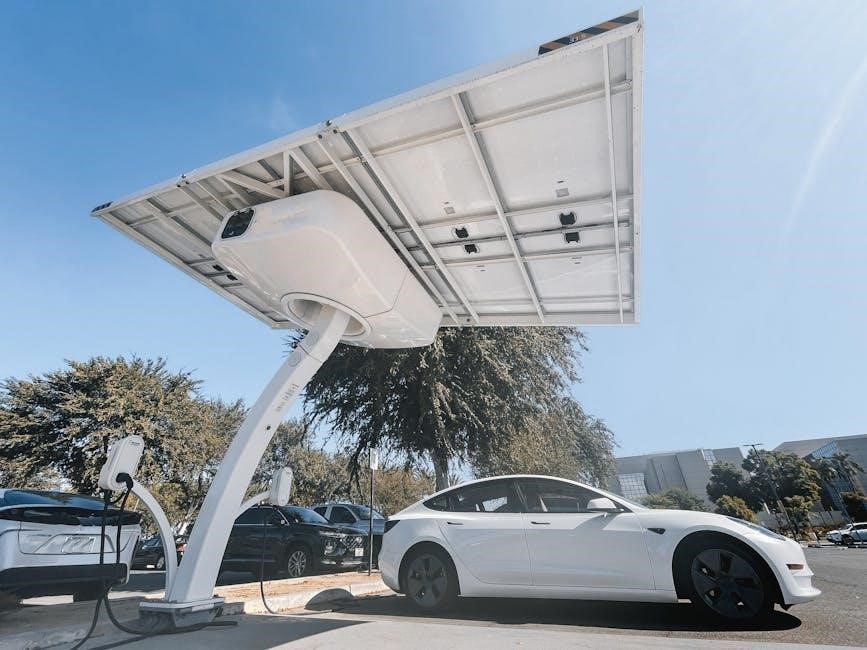An MPPT (Maximum Power Point Tracking) solar charge controller is a critical component in solar energy systems, optimizing energy harvest by adjusting voltage and current in real-time to maximize power output. Equipped with advanced algorithms and features like LCD displays, these controllers ensure efficient battery charging and system monitoring, making them a high-performance solution for solar setups.
Key Features of MPPT Controllers
MPPT solar charge controllers are equipped with advanced features that enhance their performance and efficiency. One of their standout attributes is the maximum power point tracking algorithm, which optimizes energy extraction from solar panels by adjusting voltage and current in real-time. Many models include an LCD display, providing real-time monitoring of system status, voltage, current, and battery charge levels. These controllers often support multiple system voltages, such as 12V, 24V, 36V, and 48V, with automatic voltage detection for added convenience.
They typically offer high MPPT efficiency, often reaching up to 99.5%, ensuring minimal energy loss during power conversion. Additionally, MPPT controllers usually feature three-stage charging—constant current, constant voltage, and floating charge—to ensure batteries are charged safely and efficiently. They also support various charging modes, including solar priority and battery priority, catering to different user needs.
Remote monitoring and control are available in some models, allowing users to manage their solar systems via apps or external devices. Enhanced safety features, such as overcharge protection, short-circuit protection, and reverse polarity protection, are standard. These controllers are designed to handle a wide range of solar panel configurations and are compatible with different battery types, making them versatile for various solar power applications.
Installation and Setup of MPPT Controllers
Install the MPPT controller by mounting it securely and connecting the solar panels, battery, and load in the correct order. Set the system voltage and charge parameters according to the manual for optimal performance. Proper setup ensures efficient energy management and system safety.
Safety Considerations During Installation
When installing an MPPT solar charge controller, prioritize safety to prevent damage and ensure reliable operation. Always disconnect the battery before starting the installation to avoid short circuits. Use insulated tools to handle live circuits, and ensure all connections are secure to prevent arcing. Avoid overloading the controller by adhering to its rated voltage and current specifications. Keep the controller away from flammable materials and ensure proper ventilation to prevent overheating. Ground the system correctly to protect against electrical surges and faults. Never connect or disconnect the solar panels under load, as this can cause voltage spikes. Use appropriate cable sizes to minimize resistance and heat buildup. Follow the manufacturer’s instructions for settings like battery voltage and charge parameters. If unsure, consult a certified technician to ensure compliance with safety standards and system requirements. Proper safety measures ensure a safe and efficient solar charging experience;

Operational Modes of MPPT Controllers
MPPT solar charge controllers operate in multiple modes to optimize energy harvesting and battery charging. The primary mode is Maximum Power Point Tracking (MPPT), which dynamically adjusts the input voltage and current to extract the maximum power from solar panels. This mode ensures optimal energy collection under varying light conditions. Additionally, MPPT controllers often feature a three-stage charging process: bulk charging (constant current), absorption charging (constant voltage), and floating/maintenance charging. Bulk charging rapidly charges the battery to 80% capacity, while absorption charging maintains a steady voltage to reach full charge. Floating mode keeps the battery topped up without overcharging. Controllers also support system voltage recognition, automatically detecting 12V, 24V, 36V, or 48V systems. Some models include a night-time disconnection feature to prevent battery drain. Advanced controllers may offer customizable charging parameters and real-time monitoring via displays or apps. These operational modes ensure efficient, safe, and adaptive charging, maximizing the performance of your solar energy system while protecting your batteries and panels.

Troubleshooting Common Issues
- Identify issues like incorrect voltage settings or battery incompatibility.
- Check for system configuration errors or loose connections.
- Adjust settings or use external sensors for accurate monitoring.
Identifying and Resolving Common Problems
When issues arise with your MPPT solar charge controller, it’s essential to identify and resolve them promptly to ensure optimal performance. Common problems include overvoltage, insufficient charging, or faulty connections. Start by checking the system voltage settings to ensure they match your battery type. If the controller isn’t charging properly, verify that the solar panel input voltage and current are within the specified range. Loose or corroded connections can also disrupt functionality, so inspect all wiring and terminals regularly.
For advanced troubleshooting, refer to the controller’s manual to understand error codes or LED indicators. If the controller fails to recognize the battery type, reset the system or reconfigure the settings. In cases of overheating, ensure proper ventilation and reduce the load if necessary. Always follow safety guidelines, such as disconnecting power sources before making adjustments. By addressing these issues systematically, you can restore your solar charging system to full efficiency and extend its lifespan. Proper installation and regular maintenance are key to minimizing potential problems and ensuring reliable operation.

Maintenance and Optimization Tips
Regular maintenance and optimization are crucial for ensuring the longevity and efficiency of your MPPT solar charge controller. Start by checking all connections regularly to prevent corrosion and ensure tightness. Use a soft cloth to clean dust or debris from the controller’s surface and vents, which can improve heat dissipation and prevent overheating.
Monitor the system performance using the LCD display or remote monitoring software to track charging status, voltage, and current levels. This helps identify potential issues early. Clean your solar panels periodically to maintain maximum efficiency, as dirt or debris can reduce energy production. Adjust the controller settings according to your battery type and environmental conditions to optimize charging performance.
For lead-acid batteries, ensure the equalization settings are configured correctly to prevent undercharging or overcharging. Regularly inspect the battery terminals and cables for damage or wear; Update the controller’s firmware if available, as newer versions often include performance improvements. Finally, ensure proper ventilation around the controller to prevent thermal stress and extend its lifespan.

Comparison with PWM Controllers
MPPT (Maximum Power Point Tracking) and PWM (Pulse Width Modulation) controllers are two common types of solar charge controllers, but they differ significantly in functionality and efficiency. MPPT controllers are more advanced, using algorithms to track and adjust the solar panel’s voltage and current to extract maximum power, especially in varying light conditions. This results in higher energy output, often up to 30% more efficient than PWM controllers.
PWM controllers, while simpler and more affordable, operate by gradually reducing the charging current as the battery approaches full charge. They are less efficient, particularly in low-light conditions, as they cannot optimize energy extraction. MPPT controllers are ideal for larger or more complex solar systems, offering features like real-time monitoring and adaptive charging. PWM controllers are better suited for smaller, basic setups where cost is a primary concern.
The choice between MPPT and PWM depends on system size, budget, and efficiency requirements. For optimal performance and higher energy yield, MPPT controllers are recommended. However, for simple, low-power applications, PWM controllers provide a cost-effective solution. Understanding these differences helps users select the most appropriate controller for their solar energy needs.




About the author